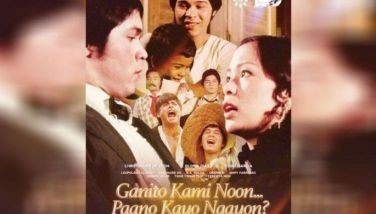Hope and heaven in the hearts of two heroines
MANILA, Philippines - “Lasciate, ogne speranza, voi chintrate. Abandon all hope ye who enter here.” This is the terrible inscription in the gate of hell, with which the Florentine renegade of the Middle Ages, Dante Alighieri, assailed the horrified readers of his Inferno. It is the same torment with which the other Dante, the controversial Filipino indie filmmaker of our time, Dante Brillante Mendoza, harrowed the viewers of his latest opus, Lola.
The film was among the official selection for Venezia 66, the first time in 25 years a Filipino film competed for Venice’s prestigious Golden Lion plum. According to the Philippine Entertainment Portal (PEP), the country’s last entry was Mike de Leon’s Sister Stella L, retitled Sangandaan.
Though bested by another remarkable indie film, Ded na si Lolo (written and directed by Soxie Topacio) for the Academy Awards, Lola nevertheless marks a milestone in filmmaking and acting in the country by two gifted Filipinos — Brillante Mendoza and Rustica Carpio respectively, who incidentally share a common academic culture, that of venerably ancient UST.
Shown last October, soon after the apocalyptic Ondoy drowned so many dreams into desperation, the film gnawed at the dramatic irony of our recent calamity and what Edith Wharton wrote: That life is the only real counselor, and that wisdom unfiltered through personal experience does not become a part of the moral tissue. Coming on the heels of the 2009 Kinatay, where he won Best Director for the 62nd Cannes Film Festival, this is a telling chapter on the controversial career of UST Fine Arts alumnus Mendoza, who was both director and production designer for the poignant story written by Lynda Casimiro.
Indeed, the film is a chronicle of what social anthropologists and literary realists consider the “sordid life of the downtrodden” in the city of woes that is Metro Manila, immortalized on film by Brocka’s 1975 classic, Maynila sa mga Kuko ng Liwanag, adapted by Clodualdo del Mundo from the novel by Edgardo Reyes. But it is in precisely underscoring the gloom and doom of the city and the two old women’s tenacity to survive in it, where the remarkability of the film lies.
The opening sequence of one grandmother, Lola Sepa (Anita Linda), trudging the slippery sidewalks of Quiapo, unmindful of the pouring rain and blustering wind, just to be able to light a candle in the sordid spot under the Quezon Bridge, where her grandson was murdered the day before. The contrapuntal segments of the other grandmother, Lola Puring (Carpio), ascending and descending the interminably winding staircase of the city jail to bring decent food to her grandson, now in jail for the crime. Both are agonizingly protracted scenes of pure pathos which the director shoots on his digital camera in real time, painfully reminding us that life is an insane drudgery, where the weak and the powerless have no recourse but to endure the inexorable passage of time.
The fabled Rustica Carpio, another Thomasian (her Ph.D. in Literature dissertation at the UST Graduate school was published as a book on Hermogenes Ilagan, Father of the Tagalog Zarzuela) who taught Literature and Communication Arts in premiere universities while acting in sublime films (by the likes of Ishmael Bernal, Maryo delos Reyes, Lamberto Avellana, Eddie Romero and Jose Javier Reyes, among others), just published her book with the Far Eastern University Publications, where she used to be director of the President’s Committee on Culture and the Arts. Titled Shuttling from Stage to Screen, it chronicled her long and illustrious career on stage and the silver screen, perhaps little knowing that there will be another film like Lola to add to her lush crown of acting laurels.
While she was not the original choice for the role (Mona Lisa suffered a stroke), Dr. Carpio rose to the occasion and proved what FEU President, Dr. Lydia Echauz remarked as a perfect example of one who, being well-loved and affirmed by her family of artists, goes on to develop the inborn seeds of her talents to inspiring, exciting and effortless fruition.
As an aging matriarch whose family’s salvation is pinned on her frail shoulders, she revealed a vast acting repertoire: Ruthless (as she cons her customers to earn a few more pesos), stoic (as she endures the ill temper of her other grandson after she hocks the only television set in the house); devoted (as she untiringly feeds her invalid son) and smart (as she vends by the train station the vegetables and fowls given by a relative in the province who had no money to spare). She is true to her name, Purificacion, the purifying love of a mater dolorosa without the depressing pasan ko ang daigdig angst of so many melodramatic movie heroines.
As an admiring student, I can only pray that critic Mario Bautista’s words will be prophetic when he wrote: She gets the role of her career here in Lola and delivers a solid, touching performance that should merit a Best Actress nomination.
All told, Lola is another acerbic commentary on the travails of our country. The grinding poverty of the masses that pillories old women like Sepa and Puring to hard incessant labor to support their multi generation families. The ineptitude of our government, which cannot provide the basic services, that makes it imperative for them to deconstruct the legal and judicial system. The travesty of religious institutions which cannot even bury its dead with the dignity all human beings deserve, that necessitates the impetus to rework morality.
The film is a dirge, slow-moving and mournful like the lot of the abjectly poor drifting on the murky waters of Sitio Ilog in Malabon, where the tide is always high with misery, sickness, hunger and death.
But Lola is also an ode to the unconditional love that only women can find in their hearts to give as the two magnificent heroines intertwined by a senseless death yielded with the last ounce of their strength. For Filipino women like Sepa and Puring, the French poet, statesman and historian Alphonse de Lamartine concluded: Grief knits two hearts in closer bonds than happiness ever can; and common sufferings are far stronger links than common joys.
Cut into stone were Il sumo poeta Dante’s anaphoric condemnation of the nine circles of hell: I am the way into the city of woe/I am the way to a forsaken people/I am the way into Eternal Sorrow; but etched in the hearts of Sepa and Puring is the inscrutable love for family, as Dante Mendoza’s metonymic affirmation of the nine spheres of paradise. With lolas like them, hope springs eternal in the Filipino soul.
- Latest
- Trending






























